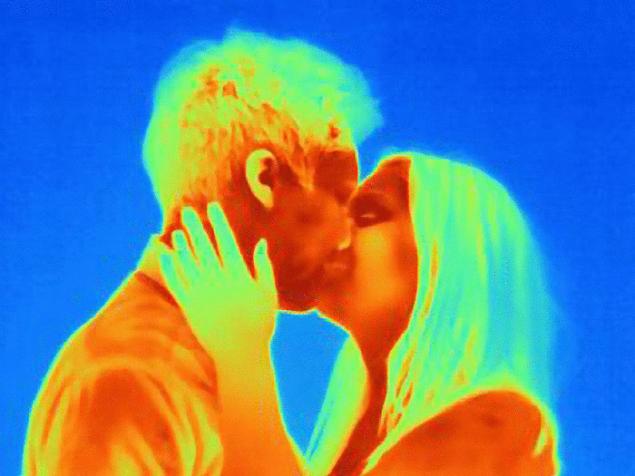585
Love formula or 5 facts that will appeal to romantics
Thirty three million eight hundred ninety five thousand nine hundred forty one
We think that the ability to love sets us apart from most animals. But from the point of view of science all the romantic feelings just a trick selfish and cynical genes, with the only desire — an endless reproduction. Photos of couples in love, taken with the imager. Different colors correspond to different temperatures. The warmest areas are shown in white, followed by red, yellow, green, blue, Indigo and finally, the cold black.

Photo: DIOMEDIA
PHYSIOLOGY.Dose of passion Professor of the albert Einstein College Lucy brown with magnetic resonance imaging found that lovers who think of their partners, most notably it activates the same areas of the brain when you use cocaine. In other words, thoughts about loved ones bring the same pleasure, like a drug.
The TRICK
From the point of view of the evolution of any living creature is just a set of genes that copy themselves. Genes can acquire new cells to grow organisms interact with each other, but in the end mark in history will leave only those who manage to keep their copies. To achieve the goal, the genes go to all sorts of tricks. Some rely on simplicity and efficiency and in minimum time produce a maximum of copies. For example, bacteria are divided in two, and Hydra otoskopia from new organisms. This is called asexual reproduction. Other genes act smarter. They do not just replicate themselves, but are mixed with other genes and create offspring from the resulting mixture. This is the essence of sexual reproduction that gave living beings a choice: who would "mix" to provide the offspring greatest success? Asexual reproduction only focused on the number. It is important for a sexual quality. The strategy of "pick and mix it up" proved to be extremely effective. She helped the genes to develop the entire planet, from mountain tops to the sea floor. Using sexual reproduction, the genes have built for themselves a complex machine like the human body — all in order to continue to replicate itself. But what if us as adults are reasonable people — not interested in the intentions of our genes? What if we don't want to breed? Of course, genes have provided it. To deceive someone, they invented love. American anthropologist Helen Fisher shared the love on three biological components: lust, attraction and привязанность1. As the planes separate motors work independently from each other, and in the brain three components of love self control our emotions and desires. You can feel affection for one partner, attraction to another and at the same time excited at the sight of racy photographs some third party.
LUST
Lust, or libido is the desire at all costs to participate in sexual reproduction. With whom, for what purpose and with what outcome — not so important. The importance is the process, not the result. The mission of desire and lust ends at the time of transfer of genes. Choose long-term partners of people made oxytocin.
Analog of human lust can be considered the response of animals to pheromones. For example, they are isolated adult mouse males. Molecules of pheromones into the nose of the mouse is female, associated with special receptors on nerve endings. They transmit the signal "it's Time to multiply!" directly into the brain, which immediately begins to command: "To prepare for ovulation, sex hormones pumped into the blood, the male was out of sight not to be missed!" Lust is the main motor reproduction, and in Homo sapiens it works on sexual hormones: estrogens and androgens. An ancient mechanism, lust is blind, and morality is powerless against her oppression.
ATTRACTION
If for lust all around the same level of attraction is being selected, for which all was intended. The DOE will give preference to winning a battle male. Young lady going on a date with the most charming boyfriend. From the point of view of neurophysiology the difference between these events there. But what if we are not interested in the intentions of our genes? What if we don't want to breed? Of course, genes have provided it. To deceive someone, they invented love.
The main substance responsible for the attraction, which is also called love, is considered to be dopamine. Should the level of dopamine in the brain rise, comes the euphoria, a person becomes hyperactive, loses appetite and sleep, worry over nothing and at the same time begins to think better. The same effect cause, for example, cocaine and amphetamines, which cause the body to "squeeze" the whole dopamine. Why genes make a person nervous, but happy and smart? The answer is simple: the machine for carrying genes should overcome any difficulties, but to bring the matter to sexual reproduction with the selected partner. And to make it as fast as possible, until the other wants to participate in the mixing of genes. That is why love is so very nervous and sees only one way out of the painfully-sweet condition: to achieve a lady's heart. And, of course, to deliver genes where it should.
ATTACHMENT
Affection came from living beings in evolutionary terms very recently. Add-on lust originated around 120-150 million years ago in mammals and the first birds. This is not surprising: if the lust and attraction is based on the obvious, the momentary observation and immediate sensations, the attachment requires a look into the future, and it is much more difficult.
THEORY
The chemistry of life is the Theory that genes, not organisms, are the object of evolution, known as geocentricity approach. In 1976, his brilliantly popularized by the biologist Richard Dawkins. In the book "the Selfish gene" he explains that, after chemically originated DNA sequences capable of copying themselves, they began to compete with each other. The advantage of received fragments, which are reproducing themselves more effective than others. Over time, genes were encode enzymes able to copy DNA and proteins, protecting them from external influences. Gradually, machines for carrying and reproduction of genes is more complicated, but their behavior is still determined by the needs of genes, rather than organisms. Geocentricity theory explains these counterintuitive at first glance, the phenomenon of altruism and vnutrivenno competition of genes (a phenomenon where some genes are transmitted to offspring with a greater frequency than the others). Why do genes have invented such a complex mechanism? If you imagine that offspring appears immediately after fertilization and immediately begins an independent life, affection even harmful: what is the point to limit reproduction by only one set of genes? But the more complex it became in the course of evolution living creatures, the more time and energy demanded of their posterity. To make the new bacterium, enough twenty minutes and a pinch of sugar. To receive a new man, we need nine months of pregnancy, comfort, special diet, painful childbirth and a couple dozen years care and education. With the increasing complexity of animal breeding has become protracted, which you need to plan in advance. Change sexual partners like gloves became unprofitable if the relationship ends after fertilization, then who will search for food? Either attraction or lust does not take such difficulties into account. Their mission ends when the genes transferred to the next generation. Needed a way to make machines for the reproduction of choose long-term, not just an attractive partner. Home "molecule attachment" hormone oxytocin. It is in large quantities allocated in childbirth, help cope with pain and further to forget about it. This hormone promotes the release of milk directly affects the manifestation of tenderness to children and stimulates parental behavior. Oxytocin increases the desire to spend time with a partner, communicate with them on a social and physical contact. We can say that oxytocin — the hormone of plans for the future.
LOVE
System that lust, attraction and attachment in humans, there are in other mammals. In studies of the role of oxytocin, for example, often use the steppe voles — these rodents are monogamous and tied to a partner. But this does not imply that voles love means the same thing to humans. You need to look for a reference point that we call love. It is believed that appearance of love in humans is associated with the early evolution of anthropoids.
Eight million years ago, changing the climate of West Africa forced our ancestors to leave the thinning forest and go to Savannah. In open spaces it was necessary to travel long distances, and for about four million years ago Australopithecus stood on his feet instead of climbing on trees. Erect, the female could no longer carry a child on the back, and it was difficult to find food. But bipedalism freed the hands of the males, and they began to wear produced food over long distances, instead of eating on the spot.
The evolutionary advantage received family roles: females are caring for children, males bring food. In the new conditions of the ancient oxytocin system has been extremely useful. After playing with the settings of the brain, the evolution of the "connected" to the action of the hormone rapidly developing emotions and consciousness of Australopithecus — better food and new opportunities for the education of young greatly increased his intellectual capacity. Less than three million years, as hormonal and emotional processes, invented by genes to maximize the copy themselves, covered with a dense carapace of culture. Religion glorified oxytocin, and medieval minstrels — dopamine.
But this fact should not upset people, as if losing control of your life: in the end, who is not genes, better know how to make us pleased? So relax and have fun.
источник:vokrugsveta.ru
Source: /users/1077
We think that the ability to love sets us apart from most animals. But from the point of view of science all the romantic feelings just a trick selfish and cynical genes, with the only desire — an endless reproduction. Photos of couples in love, taken with the imager. Different colors correspond to different temperatures. The warmest areas are shown in white, followed by red, yellow, green, blue, Indigo and finally, the cold black.

Photo: DIOMEDIA
PHYSIOLOGY.Dose of passion Professor of the albert Einstein College Lucy brown with magnetic resonance imaging found that lovers who think of their partners, most notably it activates the same areas of the brain when you use cocaine. In other words, thoughts about loved ones bring the same pleasure, like a drug.
The TRICK
From the point of view of the evolution of any living creature is just a set of genes that copy themselves. Genes can acquire new cells to grow organisms interact with each other, but in the end mark in history will leave only those who manage to keep their copies. To achieve the goal, the genes go to all sorts of tricks. Some rely on simplicity and efficiency and in minimum time produce a maximum of copies. For example, bacteria are divided in two, and Hydra otoskopia from new organisms. This is called asexual reproduction. Other genes act smarter. They do not just replicate themselves, but are mixed with other genes and create offspring from the resulting mixture. This is the essence of sexual reproduction that gave living beings a choice: who would "mix" to provide the offspring greatest success? Asexual reproduction only focused on the number. It is important for a sexual quality. The strategy of "pick and mix it up" proved to be extremely effective. She helped the genes to develop the entire planet, from mountain tops to the sea floor. Using sexual reproduction, the genes have built for themselves a complex machine like the human body — all in order to continue to replicate itself. But what if us as adults are reasonable people — not interested in the intentions of our genes? What if we don't want to breed? Of course, genes have provided it. To deceive someone, they invented love. American anthropologist Helen Fisher shared the love on three biological components: lust, attraction and привязанность1. As the planes separate motors work independently from each other, and in the brain three components of love self control our emotions and desires. You can feel affection for one partner, attraction to another and at the same time excited at the sight of racy photographs some third party.
LUST
Lust, or libido is the desire at all costs to participate in sexual reproduction. With whom, for what purpose and with what outcome — not so important. The importance is the process, not the result. The mission of desire and lust ends at the time of transfer of genes. Choose long-term partners of people made oxytocin.
Analog of human lust can be considered the response of animals to pheromones. For example, they are isolated adult mouse males. Molecules of pheromones into the nose of the mouse is female, associated with special receptors on nerve endings. They transmit the signal "it's Time to multiply!" directly into the brain, which immediately begins to command: "To prepare for ovulation, sex hormones pumped into the blood, the male was out of sight not to be missed!" Lust is the main motor reproduction, and in Homo sapiens it works on sexual hormones: estrogens and androgens. An ancient mechanism, lust is blind, and morality is powerless against her oppression.
ATTRACTION
If for lust all around the same level of attraction is being selected, for which all was intended. The DOE will give preference to winning a battle male. Young lady going on a date with the most charming boyfriend. From the point of view of neurophysiology the difference between these events there. But what if we are not interested in the intentions of our genes? What if we don't want to breed? Of course, genes have provided it. To deceive someone, they invented love.
The main substance responsible for the attraction, which is also called love, is considered to be dopamine. Should the level of dopamine in the brain rise, comes the euphoria, a person becomes hyperactive, loses appetite and sleep, worry over nothing and at the same time begins to think better. The same effect cause, for example, cocaine and amphetamines, which cause the body to "squeeze" the whole dopamine. Why genes make a person nervous, but happy and smart? The answer is simple: the machine for carrying genes should overcome any difficulties, but to bring the matter to sexual reproduction with the selected partner. And to make it as fast as possible, until the other wants to participate in the mixing of genes. That is why love is so very nervous and sees only one way out of the painfully-sweet condition: to achieve a lady's heart. And, of course, to deliver genes where it should.
ATTACHMENT
Affection came from living beings in evolutionary terms very recently. Add-on lust originated around 120-150 million years ago in mammals and the first birds. This is not surprising: if the lust and attraction is based on the obvious, the momentary observation and immediate sensations, the attachment requires a look into the future, and it is much more difficult.
THEORY
The chemistry of life is the Theory that genes, not organisms, are the object of evolution, known as geocentricity approach. In 1976, his brilliantly popularized by the biologist Richard Dawkins. In the book "the Selfish gene" he explains that, after chemically originated DNA sequences capable of copying themselves, they began to compete with each other. The advantage of received fragments, which are reproducing themselves more effective than others. Over time, genes were encode enzymes able to copy DNA and proteins, protecting them from external influences. Gradually, machines for carrying and reproduction of genes is more complicated, but their behavior is still determined by the needs of genes, rather than organisms. Geocentricity theory explains these counterintuitive at first glance, the phenomenon of altruism and vnutrivenno competition of genes (a phenomenon where some genes are transmitted to offspring with a greater frequency than the others). Why do genes have invented such a complex mechanism? If you imagine that offspring appears immediately after fertilization and immediately begins an independent life, affection even harmful: what is the point to limit reproduction by only one set of genes? But the more complex it became in the course of evolution living creatures, the more time and energy demanded of their posterity. To make the new bacterium, enough twenty minutes and a pinch of sugar. To receive a new man, we need nine months of pregnancy, comfort, special diet, painful childbirth and a couple dozen years care and education. With the increasing complexity of animal breeding has become protracted, which you need to plan in advance. Change sexual partners like gloves became unprofitable if the relationship ends after fertilization, then who will search for food? Either attraction or lust does not take such difficulties into account. Their mission ends when the genes transferred to the next generation. Needed a way to make machines for the reproduction of choose long-term, not just an attractive partner. Home "molecule attachment" hormone oxytocin. It is in large quantities allocated in childbirth, help cope with pain and further to forget about it. This hormone promotes the release of milk directly affects the manifestation of tenderness to children and stimulates parental behavior. Oxytocin increases the desire to spend time with a partner, communicate with them on a social and physical contact. We can say that oxytocin — the hormone of plans for the future.
LOVE
System that lust, attraction and attachment in humans, there are in other mammals. In studies of the role of oxytocin, for example, often use the steppe voles — these rodents are monogamous and tied to a partner. But this does not imply that voles love means the same thing to humans. You need to look for a reference point that we call love. It is believed that appearance of love in humans is associated with the early evolution of anthropoids.
Eight million years ago, changing the climate of West Africa forced our ancestors to leave the thinning forest and go to Savannah. In open spaces it was necessary to travel long distances, and for about four million years ago Australopithecus stood on his feet instead of climbing on trees. Erect, the female could no longer carry a child on the back, and it was difficult to find food. But bipedalism freed the hands of the males, and they began to wear produced food over long distances, instead of eating on the spot.
The evolutionary advantage received family roles: females are caring for children, males bring food. In the new conditions of the ancient oxytocin system has been extremely useful. After playing with the settings of the brain, the evolution of the "connected" to the action of the hormone rapidly developing emotions and consciousness of Australopithecus — better food and new opportunities for the education of young greatly increased his intellectual capacity. Less than three million years, as hormonal and emotional processes, invented by genes to maximize the copy themselves, covered with a dense carapace of culture. Religion glorified oxytocin, and medieval minstrels — dopamine.
But this fact should not upset people, as if losing control of your life: in the end, who is not genes, better know how to make us pleased? So relax and have fun.
источник:vokrugsveta.ru
Source: /users/1077























